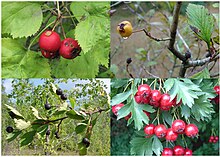This article's citation style may be unclear. (August 2020) |
This article has a list of references or other websites, but its sources are not clear because it does not have inline citations. (August 2020) |
Crataegus (commonly called hawthorn) is a large genus of shrubs in the family Rosaceae. They are found in Europe, Asia and North America. The name hawthorn used to be used for the species found only in northern Europe but is now used for the entire genus. The same name is also used for the related Asian genus Rhaphiolepis.
| Hawthorns | |
|---|---|

| |
| Fruit of four different species of Crataegus (clockwise from top left: C. coccinea, C. punctata, C. ambigua and C. douglasii) | |
| Scientific classification | |
| Kingdom: | Plantae |
| Clade: | Tracheophytes |
| Clade: | Angiosperms |
| Clade: | Eudicots |
| Clade: | Rosids |
| Order: | Rosales |
| Family: | Rosaceae |
| Subfamily: | Amygdaloideae |
| Tribe: | Maleae |
| Subtribe: | Malinae |
| Genus: | Crataegus Tourn. ex L. |
| Type species | |
| Crataegus rhipidophylla [1] | |
Hawthorn are shrubs and small trees. They grow to 5-15 m tall and have small fruit. The fruit are called haws.
References
change- ↑ J. B. Phipps (1997). Monograph of northern Mexican Crataegus (Rosaceae, subfam. Maloideae). Sida, Botanical Miscellany. Vol. 15. Botanical Research Institute of Texas. p. 12. ISBN 9781889878294.
Other websites
change- Photos of Chinese haw berries Archived 2006-05-19 at the Wayback Machine
- Medicinal uses of Hawthorn in Armenia
- Edible uses of hawthorns at Plants For A Future Archived 2006-04-23 at the Wayback Machine
Wikimedia Commons has media related to Crataegus.